Description and handling of notched trowels
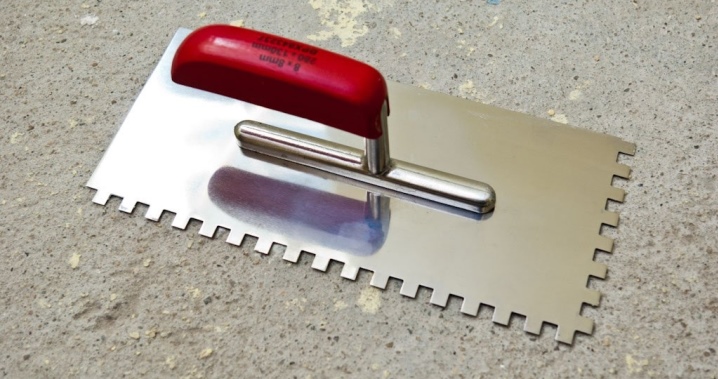
The use of construction tools is an integral part of the renovation process, so you need to choose the right one. The speed of work and their quality depends on the quality of the product and the correct selection of the option. Almost every repair is not complete without putting putty on the walls, for which a spatula is required. The convenience and simplicity of this tool made it possible to use it for other tasks as well. One of the varieties is a notched trowel, its features and characteristics will be discussed below.
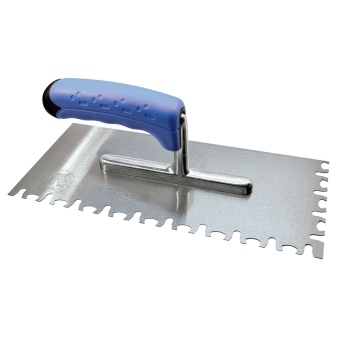
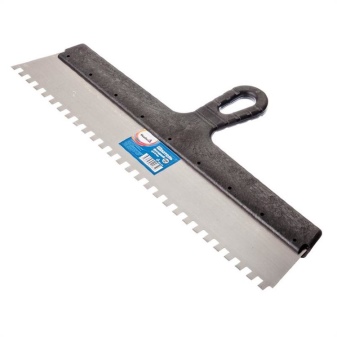
What is it and what is it for?
Notched trowels are relatively recent. Previously, laying tiles and other coatings had to manually level the adhesive or cement, which took a lot of time and effort. In this regard, the transformation of a conventional spatula into a notched one took place.
A notched trowel, called a "comb", has a handle like a conventional trowel and a working surface, one or more sides of which are presented in the form of teeth. You can use a comb:
- for laying tiles on the wall;
- for laying tiles on the floor;
- to create a mosaic;
- for placing linoleum;
- to create a self-leveling floor.

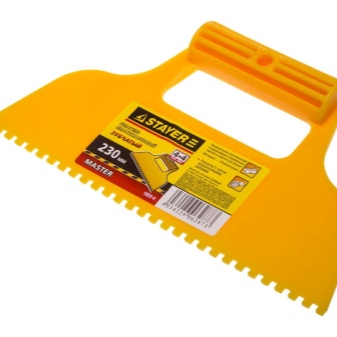
Thanks to the notched trowel the glue mass is evenly applied to the surface, allowing the tiles to be laid out neatly. Due to the different sizes and weights of tiles, it is important to choose the right tool for working with it. For floor glue, it is worth using a comb with large teeth, since you will need more glue; for work on the wall, you can take a trowel with a smaller notch size to distribute the composition in a thin layer. The tool with the largest teeth is required for aerated concrete or heavy tiles.
The front version of the spatula depends on the size of the finishing materials and their weight: the smaller and lighter they are, the thinner the adhesive layer will be, and vice versa.


The prongs can be graded in size from 2 to 20 mm, the shape happens rectangular, semicircular and triangular. The spatula itself can be rectangular or in the form of a trowel, according to the material - metal and plastic.
By using a notched trowel it is possible to:
- lay out tiles or other building material as evenly as possible, evenly distributing the adhesive composition;
- carry out the work as quickly as possible;
- achieve good adhesion to the surface due to the optimal amount of glue on it;
- reduce the consumption of glue for work.


Species overview
In view of the large assortment of notched trowels, it is important to choose the right not only the shape, but also the version of the tool, based on the designations on it. Each tool has its own letter and number.
The alphabetic value indicates the shape of the product, and the number indicates the size of the teeth.



There are such letters:
- A;
- B;
- C;
- S;
- R;
- M.
Each letter is numerically scaled to indicate the size of the trowel teeth. For example, A1 and A2 are triangular toothed tools, where in the first case the width of the tooth is 0.6 mm, and in the second it is 1.2; in addition, other parameters differ: the width of the depression is 1.4 and 1.8, the depth of the depression is 1.1 and 1.5, the notch angle in both versions is 55 °.

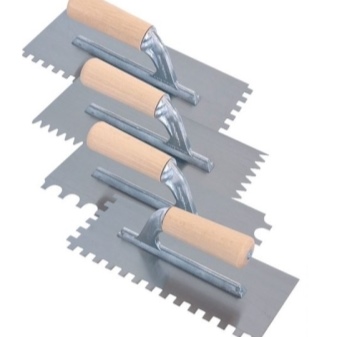
The combed trowel marked A has the smallest triangular teeth, while the trowel marked B has larger teeth. B1 has a tooth width of 2.7, a root width of 2.3, a root depth of 2, and the same 55 ° tilt angle as the A-trowel.
When choosing a high-quality and good spatula, it is important to know what markings can be indicated on it. For products with the letter A, there are tools on sale with the numbers 1, 2, 3, 4, 5. Spatulas with the letter B have a wider selection: on the shelves you can see products with numbers 1, 2, 3, 5, 6, 7, 8 , 9, 10, 11, 12, 13, 14, 15, 16 and 17.


The comb with the letter C has a square shape, among the assortment you can see products with the numbers 1, 2, 3, 4, 5. The tool with the letter S has a triangular shape, but without gaps. There may be products on sale with the numbers 1, 2, 3, 4. The spatula with the letter R has rectangular teeth of regular and irregular shape. Among the options there may be numbers 1, 2, 3. The semicircular comb is represented by the designation M1.
To know for which materials to use this or that spatula, you need to understand what is the peculiarity of each option.

By the shape of the teeth
At the moment, there are 6 types of notched trowels that can be used for repair work. Each of them differs in the shape of the teeth.
- A - the shape of the teeth is triangular, the gaps between them are minimal. This tool is considered universal, with its help you can carry out most of the repair work.
- B - The teeth are also triangular, but the gap between them is increased, which allows more glue to be applied.
- C - products with square teeth. This trowel is used for laying tiles.
- S - the shape of the teeth is triangular, there are no gaps between them. Used for laying PVC tiles.
- R - the teeth are rectangular, the shape is different. It can be used to lay large tiles on a non-uniform substrate, applying more glue to the surface.
- M - semicircular shape of the teeth. Such a comb is needed for the installation of a warm floor, when work is carried out with a concrete or synthetic base, which spreads strongly.


You can correctly determine the shape of the teeth based on the building material with which the work will be done. To make this process as efficient as possible, it is important to choose the right size of the teeth.
To size
When choosing the right equipment for work, it is important to navigate in the weight and dimensions of building materials that will be used in the repair. It is recommended to purchase a spatula of the same width as the tile in order to minimize the cost of glue, make the process more convenient and speed up the pace.
Among the most popular and demanded models, it is worth highlighting the following:
- 0.6 and 1.2 mm - these are products with the smallest teeth, allowing a thin layer of glue to be applied for decorative work;
- 3 mm - the optimal size of the teeth for laying glass or ceramic mosaics;
- 4 mm - suitable for laying small tiles, no more than 12x12 cm;
- 6 mm - is the most popular and versatile, as it is suitable for working with tiles of any size up to dimensions of 20x20 cm;
- 8 mm - a spatula for laying tiles up to a size of 30x30 cm;
- 10 mm - a comb for laying heavy tiles with a thickness not exceeding 10 mm;
- 12 mm - trowel for laying the heaviest tiles.
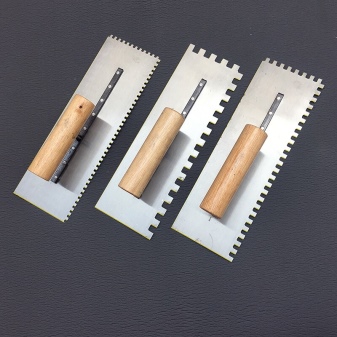
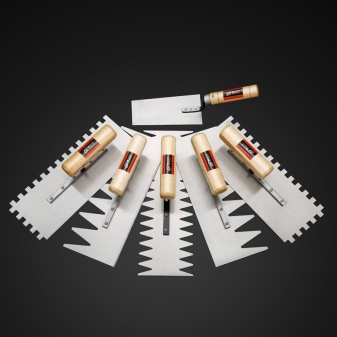
The height of the teeth plays an important role in the quality of the job. If the amount of glue is small, then the tile will not adhere well and will begin to fall off over time. When too much adhesive is applied to the surface, it is difficult to align the tiles evenly, and the finished surface may have errors. In addition, such a composition dries much longer.
To check whether the spatula is correctly selected, it is necessary to apply a small amount of the composition, attach the tile and press it: if a lot of glue comes out, it means that the comb has too high a tooth height; if there is no glue at all, it may be worth increasing the size of the teeth. Beginners are encouraged to try the 600 mark, which is suitable for most jobs.

It is best to have 2-3 spatulas to change them depending on the size and thickness of the tile you are going to work with.
By material of manufacture
On sale you can find notched trowels made of two materials.
- Metal - spatulas are made of stainless steel, they are durable, wear-resistant, not afraid of corrosion. The teeth of such a product are not deformed, which makes it possible to evenly distribute the composition over the surface, and this is very important in the process of laying tiles and other building materials. The cost of such a product is quite high.
- Plastic - a plastic notched trowel is a cheaper replacement for a metal one. It is lightweight, can be made in different colors, have any shape and size. The disadvantages include the fragility of the product. Over time, the prongs will begin to bend, which will prevent the adhesive from spreading evenly over the entire surface. Another significant problem can be broken teeth, which will completely ruin the workflow. You can use such spatulas for one-time and small work, they will not work for a long service life.


How to choose a comb?
In order to choose the right notched trowel that suits the quality and usability, it is important to know what to look for. The most important factors are as follows.
- Spatula size - it is optimal if the dimensions of the tile and the tool are the same. If you do not have the necessary products, then it is better to take a larger spatula.
- Handle comfort - the size, shape and material of the handle should be suitable for the person who will work with it. With an incorrectly chosen tool, where the handle will be small or, conversely, long, irregular in shape, or have other flaws, the work will significantly slow down, its quality will suffer. When choosing between a wooden and a plastic handle, it is worth taking plastic, as it is lighter, more convenient and more practical.
- Rigidity of the base of the product - for comfortable work, the main part of the spatula should bend slightly. Too hard or very soft tools are inconvenient to work.
- Price - it is better to make a choice towards more expensive products, but it is not necessary to look at brands - there the price will be overpriced. Focusing on the main indicators of quality and convenience, you can find the best option.


How to use it correctly?
Working with a notched trowel is not particularly difficult, but there are various tile laying techniques.
- Application of adhesive solution to the base, where the tile will be glued.
- Distribution of adhesive over tiles, leveling with a trowel and laying on the surface.
- Applying the adhesive to the work surface with a spatula, holding the glue with a toothed tool and applying the removed ball to the tile. It is necessary to remove the adhesive from the tile with a fine-toothed spatula and lay the tile on the surface in this form.
Tiles can be laid using any of the above techniques. The first option is the fastest and is suitable for both amateurs and professionals. The second is longer, but allows you to achieve a neat result. With the third method, even very heavy tiles can be securely fixed without creating voids underneath. The choice of the installation method is made by the master himself, based on the availability of time for repairs, qualifications and the scope of work.

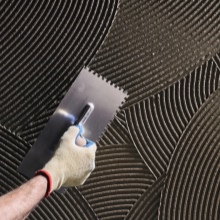














The comment was sent successfully.